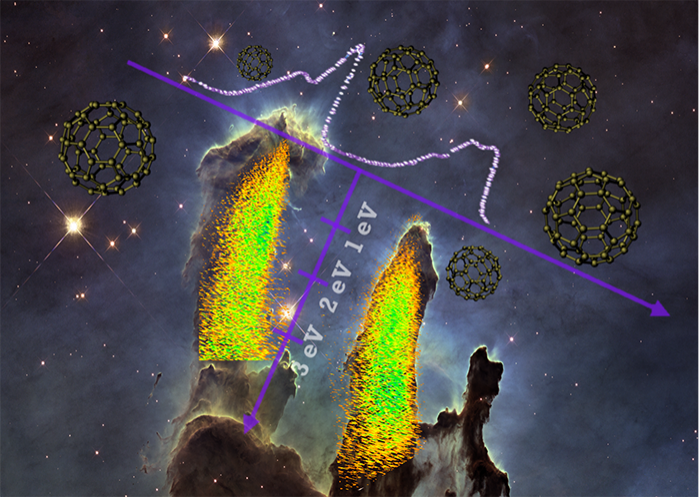Of the 200+ molecules that have been detected in space, the Buckminsterfullerene (C60), shaped exactly like a football, is extraordinarily elegant and symmetric. When exposed to harsh interstellar ultraviolet radiation, Buckminsterfullerene ionizes, i.e. loses an electron.
Scientists from Laboratory for Astrophysics, Leiden University (Netherlands) and DESIRS beamline investigated into the dynamics of C60 ionization with the high energy UV (VUV) photons produced on this beamline. The spectral fingerprints of ionized C60+ unveiled that upon losing an electron, the carbon cage starts dynamically contracting and hence, loses its spherical symmetry.
In space, molecules are exposed to harsh ultraviolet radiation and as a result, they either break apart or ionize. With its football shape (a closed-cage comprising pentagons surrounded by hexagons - see Figure 1), the structure of C60 is very robust, that’s why it preferentially ionizes upon interacting with interstellar photons.
This prompted the scientists' investigation into the dynamics of C60 ionization with VUV photons at the DESIRS beamline at SOLEIL. By analyzing the slowest (or so-called threshold) photoelectrons that are produced upon ionization of C60, they could measure the spectral fingerprints of ionized C60+. The analysis of the spectrum unveiled that upon losing an electron, the carbon cage starts dynamically contracting and hence, loses its spherical symmetry.
The electron that is lost originates from a molecular orbital located in an imaginary waistband around the spherical structure of C60. Thus, when an electron is lost, the rest of the molecule attempts to “fill in the blank” and contracts outward to match the lost electron density. Thus, when C60 ionizes, it goes from being a ball to an oblate spheroid. Like a football a moment after it was kicked by a player.
Although this has been documented before, it seems that there is a clear discrepancy between measurements and computations, where the final symmetry of the “kicked football” differs between the two. Computations predict two different structures where one is marginally more stable than the other. These measurements, however, show that the less stable symmetry is favored in the gas phase.
The reasoning for this discrepancy is unclear although the temperature of C60 in this experiment as a possible contributor cannot be eliminated. On the other hand, C60 is a very big and complex molecule to computationally describe. So, for future computational studies, the scientists obtained other measurable quantities such as partial photoionization cross sections and anisotropy parameters of the ejected photoelectrons that can be used as benchmarks to guide future calculations.

Figure 1. Ionization of C60 molecules by irradiation of VUV photons in space. Two of the lowest energy photoelectron bands are inspected in detail in this study. The very slowest photoelectrons give rise to the threshold photoelectron spectrum which unveils the characteristic symmetry of gaseous C60+.
Besides the fundamental dynamics of the ionization of C60, this work may also impact other research areas in astrophysics. More specifically, research into the diffuse interstellar bands (DIBs) – a set of interstellar absorption lines whose (molecular) origins have remained a mystery for almost a century.
Recently, four of the known DIBs were assigned to transitions in the C60+ ion which was a remarkable surprise considering that the most complex molecule detected in the diffuse interstellar medium up to that point was C3. Although this assignment is quite definitive, the origins of these transitions are not. . This is where the symmetry of the molecule becomes important because it is intrinsically linked with the allowed excitations / transitions that give rise to the spectra of molecules. The scientists hope that their results can help shed light on these transitions and give insights into where other DIB carriers may possibly be found.
This work was published in PCCP and was chosen for the back cover of the issue.
